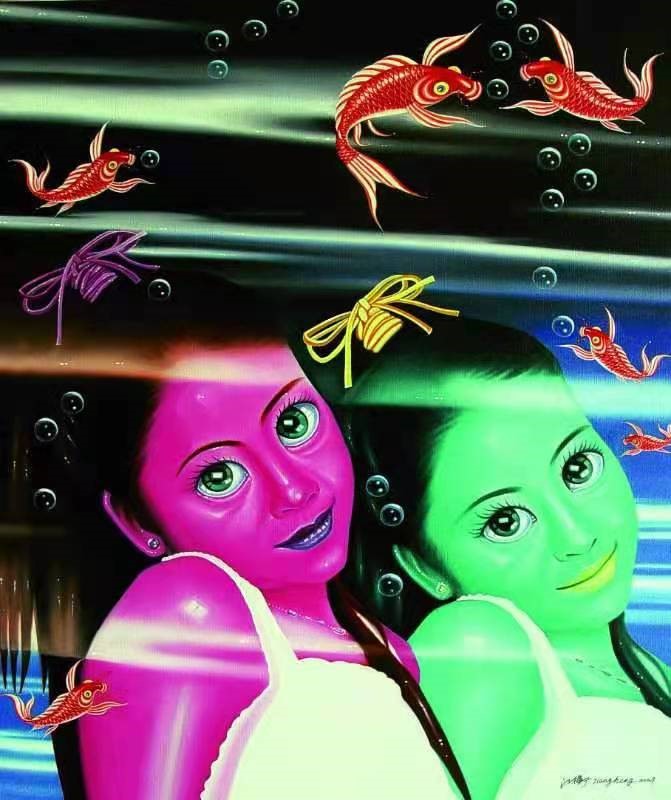As is widely known, Jiang Heng is a leading player of the Guangzhou-based Cartoon Generation that dominated the Chinese art world in the late 1990s. It was a rare phenomenon, not just in China but in the entire world, that cartoon or animation emerged as a major artistic movement in painting.
Jiang Heng began in Guangzhou, a city of southern China, by the time when the Cynical Realism and Political Pop in Beijing were nearing the end of their success. Two art movements were running for different goals. The first was, for instance, a powerful message for the outer worlds, social and political worlds, whereas the second, Cartoon Generation, was a journey in which artists were seeking after a question of identity concerning the questions, what affected us and how we grow. Lee Jin-myung(Korea,2007.

The phenomenon of “aesthetic insensitization” of art in the 20th century was not only reflected through ugliness, but also on inhumanness. As early as 1913, Guillaume Apollinare has once said, “Primarily, artists are a group of people who want to become inhumane. They are persistently pursuing traces of inhumanity.” In 1925, Ortega y Gasset has made such diagnosis: the typical characteristic of contemporary art is to “make art inhumane”. Maurice Merleau-Ponty had pointed out in 1948, in a criticism on Cezanne’s painting, that it has revealed, “the inhumane natural foundation where humans dwell.” Theodore Adorno used his dialectical style in Aesthetic Theory, published before his death, “Only when art resorts to the pursuit of inhumanity would it obey human nature.”

The reason why art of the 20th century rejected beauty resides in its revelation of inhumanity, and the reason accounts for that is in hoping to make men more humane. Just as Xunzi’s theory of the sinful nature in human, its goal was not to exemplify the perniciousness in human nature, but to ameliorate it. Perhaps Arthur Danto’s worry of allowing art to pursue beauty, it might not be effective in its critical or didactic functions, because people would be attracted by the beauty and the pleasant emotions evoked, by which its critical strength would be diminished.
Yet, Jiang Heng’s art tells us, one does not necessarily have to resort to ugliness in revealing inhumanity; through beauty, it is also possible. Jiang Heng’s art portrays mostly femme fatale, yet all of them are transformed into inhumane comic figures. The characteristics such as complexity, depth, and eternity of human nature can no longer be found in Jiang Heng’s comic figures of femme fatale, what is left are the inhumane characteristics of superficiality, ephemerality and fragility. The femmes fatales in Jiang Heng’s art are not those of everyday life, but the spirits or ghosts of beauty.
————————————————————————————————————————————-
实际上,江衡是90年代中期以中国广州为中心展开的“卡通一代”美术运动中最具代表性的艺术家。在中国美术史上甚至世界美术史上,将卡通或漫画、动漫等作为绘画体裁,甚至掀起以此为主体的美术运动还是首次。这次美术运动在中国南方广东省以广州为中心波澜不惊地开展时,正赶上以北京为中心的“玩世现实主义” (Cynical Realism) 和“波普艺术”(Political Pop)完满落幕的时候。这两场运动提倡的理念有着明显的不同。与前者反对官方主流的强烈要求相比,“卡通一代”则是一次寻找是什么给人们带来了影响、反省自身的成长历程,质询内部世界本质的航行。
—-李振铭(韩国2007)
20世纪艺术中的“美学的麻木化”现象,不仅体现在丑上,而且体现在非人性(inhuman)上。早在1913年,阿波利奈尔(G. Apollinaire)就曾经说过:“首要的是,艺术家是一群想要成为非人性的人。他们在孜孜不倦地追求非人性的踪迹。”1925年,格塞特(O. Gasset)做出这样的诊断:现代艺术的典型特征就是“艺术的非人性化”。梅洛·庞蒂(M. Merleau-Ponty)在1948年评论塞尚的绘画时指出,它揭示了“人类栖居其上的非人性的自然基础”。阿多诺(T. Adorno)在他死后出版的《美学理论》中用其惯用的辩证风格断言,“艺术只有诉诸非人性的追求才是忠于人性的。”[i]
20世纪的艺术之所以拒斥美,原因在于要揭示非人性,之所以揭示非人性,原因在于要让人变得更人性。如同荀子的性恶论那样,目的不是弘扬人性中的恶,而是要正视进而彻底改变人性中的恶。也许丹托担心,如果让艺术去追求美,就有可能不能实现它的批判或者教化功能,因为人们为被作品中的美和由美引起的愉快情感所吸引,从而会削弱作品的批判力量。
然而,江衡的艺术却告诉我们,对于非人性的揭示,不一定非得求助于丑;通过美,同样也可以揭示非人性。江衡的作品多以美女为题材,然而所有美女都被转变成了非人性的卡通。人性的复杂、深度、恒久等特征,在江衡的卡通美女中已荡然无存,剩下的是浅表、瞬时、易碎等非人性特征。江衡作品中的美女不是现实生活中的美女,而是美的精灵或幽灵。
――――彭锋摘之《美的回归还是美的滥用?——由江衡的作品引发的思考》









